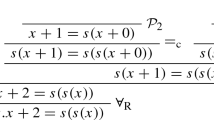Abstract
Zhang, Kapur, and Krishnamoorthy introduced a cover set method for designing induction schemes for automating proofs by induction from specifications expressed as equations and conditional equations. This method has been implemented in the theorem prover Rewrite Rule Laboratory (RRL) and a proof management system Tecton built on top of RRL, and it has been used to prove many nontrivial theorems and reason about sequential as well as parallel programs. The cover set method is based on the assumption that a function symbol is defined by using a finite set of terminating (conditional or unconditional) rewrite rules. The termination ordering employed in orienting the rules is used to perform proofs by well-founded induction. The left sides of the rules are used to design different cases of an induction sheme, and recursive calls to the function made in the right side can be used to design appropriate instantiations for generating induction hypotheses. A weakness of this method is that it relies on syntactic unification for generating an induction scheme for a conjecture. This paper goes a step further by proposing semantic analysis for generating an induction scheme for a conjecture from a cover set. We discuss the use of a decision procedure for Presburger arithmetic (quantifier-free theory of numbers with the addition operation and relational predicates >, <, ≠, =, ⩾, ⩽) for performing semantic analysis about numbers. The decision procedure is used to generate appropriate induction schemes for a conjecture by using cover sets of function taking numbers as arguments. This extension of the cover set method automates proofs of many theorems that otherwise require human guidance and hints. The effectiveness of the method is demonstrated by using some examples that commonly arise in reasoning about specifications and programs. It is also shown how semantic analysis using a Presburger arithmetic decision procedure can be used for checking the completeness of a cover set of a function defined by using operations such as + and — on numbers. With this check, many function definitions used in a proof of the prime factorization theorem stating that every number can be factored uniquely into prime factors, which had to be checked manually, an now be checked automatically in RRL. The use of the decision procedure for guiding generalization for generating conjectures and merging induction schemes is also illustrated.
Similar content being viewed by others
References
Boyer, R. S. and Moore, J S.: A Computational Logic, ACM Monographs in Computer Science, 1979.
Boyer, R. S. and Moore, J S.: A Computational Logic Handbook, Academic Press, New York, 1988.
Boyer, R. S. and Moore, J S.: Integrating decision procedures into heuristic theorem provers: A case study of linear arithmetic, Machine Intelligence 11 (1988), 83–157.
Dershowitz, N.: Termination of rewriting, J. Symbolic Computation 3 (1987), 69–116.
Jouannaud, J.-P. and Kounalis, E.: Automatic proofs by induction in theories without constructors, Information and Computation 82 (1989), 1–33.
Kapur, D.: An automated tool for analyzing completeness of equational specifications, in Proc. Int. Symp. Software Testing and Analysis (ISSTA), Seattle, August 1994, pp. 28–43.
Kapur, D., Musser, D. R., and Nie, X.: An overview of the Tecton proof system, in Theoret. Computer Science Journal, special issue on Formal Methods in Databases and Software Engineering (ed. V. Alagar), Vol. 133, October 1994, pp. 307–339.
Kapur, D., Narendran, P., Rosenkrantz, D., and Zhang, H.: Sufficient-completeness, quasi-reducibility and their complexity, Acta Informatica 28 (1991), 311–350.
Kapur, D. and Nie, X.: Reasoning about numbers in Tecton, in Proc. 8th Int. Symp. Methodologies for Intelligent Systems (ISMIS'94), Charlotte, NC, October 1994, pp. 57–70.
Kapur, D. and Zhang, H.: An overview of Rewrite Rule Laboratory (RRL) J. Computer Math. Appl. 29(2) (1995), 91–114.
Walther, C.: Combining induction axioms by machine, Proc. 12th Int. Joint Conf. Artificial Intelligence, Chambery, France, 1993.
Zhang, H.: Reduction, superposition and induction: Automated reasoning in an equational logic, Ph.D. Thesis, Department of Computer Science, Rensselaer Polytechnic Institute, Troy, NY, 1988.
Zhang, H., Kapur, D., and Krishnamoorthy, M. S.: A mechanizable induction principle for equational specifications, in Proc. 9th Int. Conf. Automated Deduction (CADE-9), Argonne, IL, LNCS 310, Springer-Verlag, 1988, pp. 250–265.
Author information
Authors and Affiliations
Additional information
Partially supported by the National Science Foundation Grant No. CCR-9303394 and subcontract CB0249 of SRI contract MDA904-92-C-5186 with The Maryland Procurement Office.
Rights and permissions
About this article
Cite this article
Kapur, D., Subramaniam, M. New uses of linear arithmetic in automated theorem proving by induction. J Autom Reasoning 16, 39–78 (1996). https://doi.org/10.1007/BF00244459
Issue Date:
DOI: https://doi.org/10.1007/BF00244459




